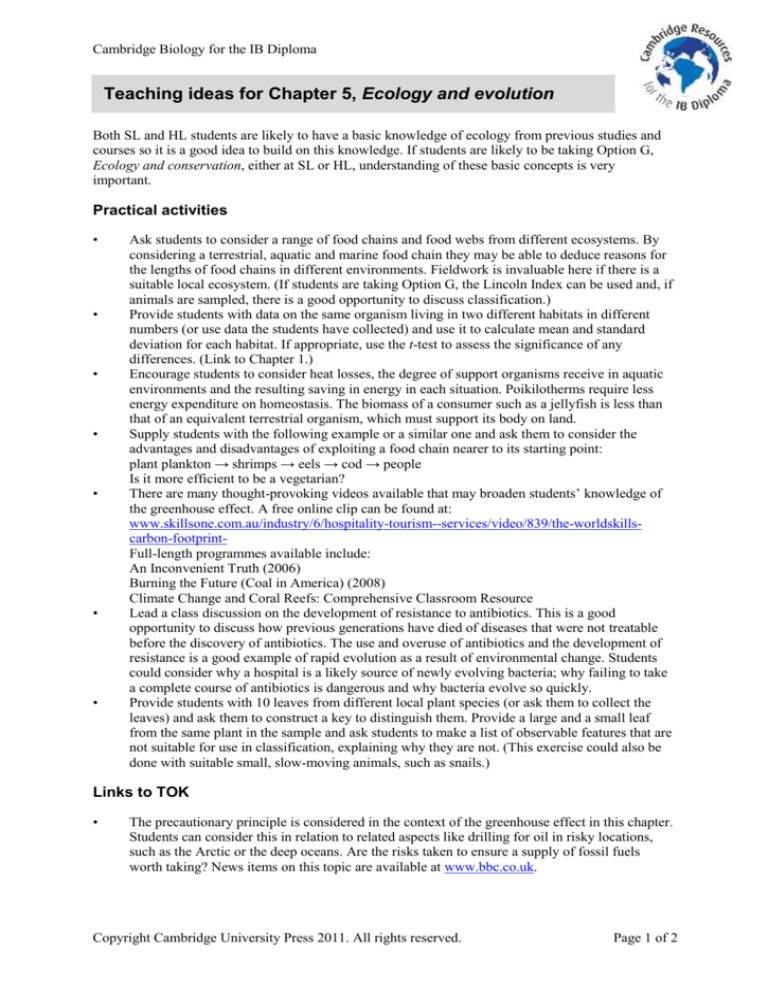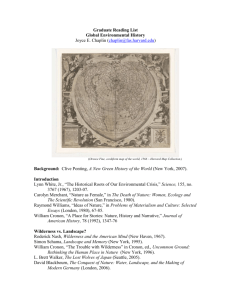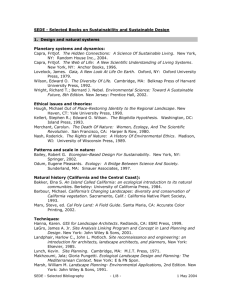
Cambridge Biology for the IB Diploma
Teaching ideas for Chapter 5, Ecology and evolution
Both SL and HL students are likely to have a basic knowledge of ecology from previous studies and
courses so it is a good idea to build on this knowledge. If students are likely to be taking Option G,
Ecology and conservation, either at SL or HL, understanding of these basic concepts is very
important.
Practical activities
•
•
•
•
•
•
•
Ask students to consider a range of food chains and food webs from different ecosystems. By
considering a terrestrial, aquatic and marine food chain they may be able to deduce reasons for
the lengths of food chains in different environments. Fieldwork is invaluable here if there is a
suitable local ecosystem. (If students are taking Option G, the Lincoln Index can be used and, if
animals are sampled, there is a good opportunity to discuss classification.)
Provide students with data on the same organism living in two different habitats in different
numbers (or use data the students have collected) and use it to calculate mean and standard
deviation for each habitat. If appropriate, use the t-test to assess the significance of any
differences. (Link to Chapter 1.)
Encourage students to consider heat losses, the degree of support organisms receive in aquatic
environments and the resulting saving in energy in each situation. Poikilotherms require less
energy expenditure on homeostasis. The biomass of a consumer such as a jellyfish is less than
that of an equivalent terrestrial organism, which must support its body on land.
Supply students with the following example or a similar one and ask them to consider the
advantages and disadvantages of exploiting a food chain nearer to its starting point:
plant plankton → shrimps → eels → cod → people
Is it more efficient to be a vegetarian?
There are many thought-provoking videos available that may broaden students’ knowledge of
the greenhouse effect. A free online clip can be found at:
www.skillsone.com.au/industry/6/hospitality-tourism--services/video/839/the-worldskillscarbon-footprintFull-length programmes available include:
An Inconvenient Truth (2006)
Burning the Future (Coal in America) (2008)
Climate Change and Coral Reefs: Comprehensive Classroom Resource
Lead a class discussion on the development of resistance to antibiotics. This is a good
opportunity to discuss how previous generations have died of diseases that were not treatable
before the discovery of antibiotics. The use and overuse of antibiotics and the development of
resistance is a good example of rapid evolution as a result of environmental change. Students
could consider why a hospital is a likely source of newly evolving bacteria; why failing to take
a complete course of antibiotics is dangerous and why bacteria evolve so quickly.
Provide students with 10 leaves from different local plant species (or ask them to collect the
leaves) and ask them to construct a key to distinguish them. Provide a large and a small leaf
from the same plant in the sample and ask students to make a list of observable features that are
not suitable for use in classification, explaining why they are not. (This exercise could also be
done with suitable small, slow-moving animals, such as snails.)
Links to TOK
•
The precautionary principle is considered in the context of the greenhouse effect in this chapter.
Students can consider this in relation to related aspects like drilling for oil in risky locations,
such as the Arctic or the deep oceans. Are the risks taken to ensure a supply of fossil fuels
worth taking? News items on this topic are available at www.bbc.co.uk.
Copyright Cambridge University Press 2011. All rights reserved.
Page 1 of 2
Cambridge Biology for the IB Diploma
Links to ICT
•
Data loggers can be used to monitor the population of an organism, such as yeast, as it
increases in an environment with limited resources. If the experiment can be left to run for
some time, a hemocytometer should record data suitable for displaying as a sigmoid growth
curve.
Aspects of internationalism
•
The greenhouse effect and the relationship between industrialization and carbon dioxide
concentration in the atmosphere is a good example of a truly global issue. Different students
could research and put forward the views of different countries from around the world and
consider which countries do and will contribute most to the problem.
Copyright Cambridge University Press 2011. All rights reserved.
Page 2 of 2












